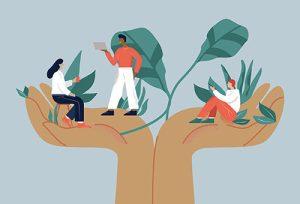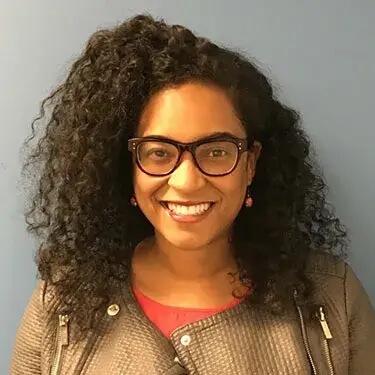FOCUS ON WELLNESS
Healing-centered environments fill gaps in educator wellness
By Jacobē Bell
Categories: Personalization, Reaching all students, Social & emotional learningApril 2023
In a climate where teachers are leaving the profession due to fatigue, burnout, and lack of support, education systems need to do more to promote teachers’ well-being than the typical wellness week events like massages and catered lunches. They need to go deeper because there is no quick fix to the stresses and challenges educators face.
To foster well-being at a deeper level, we can take inspiration from a question commonly asked in improvement science: How do we get better at getting better (Bryk et al., 2015)? This question is usually about performance, efficiency, or effectiveness. But we also need to ask: How we can get better at cultivating the well-being of our people?

I believe this starts with creating a healing-centered environment and way of being. This is different from other school climate approaches because it takes a holistic approach and is rooted in collective healing. In schools, we often talk about trauma-informed practices or social and emotional learning for students, but we don’t explicitly address how the environment influences educators or how it could better support them.
A healing-centered approach fills that gap. It has three main components: It is culturally grounded, supports restoration of identity, and supports and attends to practitioner healing (Acosta, 2020; Ginwright, 2018).
Grounding in culture. Zaretta Hammond (2014) defines culture as “the way that every brain makes sense of the world. That is why everyone, regardless of race or ethnicity, has a culture … . The brain uses cultural information to turn everyday happenings into meaningful events” (p. 22). Connecting to one’s culture can help one feel more grounded, so by making all cultures matter in schools, we can cultivate a healthier work environment.
Reflection prompts can encourage culturally grounded wellness practices by changing our thinking habits, which in turn shape actions. These prompts might include asking yourself and your teams:
- Who are our teachers? What are their cultures and subcultures?
- What are the cultural values present in our school community?
- What are the cultural practices for healing that we champion, and what are those we push unwittingly to the side?
Affirming identity and humanity. Identity and culture are intertwined. Identity is who you are and is influenced by a unique set of characteristics, lived experiences, and social roles. Attending to identity can provide a sense of belonging, well-being, and confidence. But, in many schools, identity is not affirmed or celebrated, and this has caused harm to many educators because it slowly adds emotional weight and exacerbates tiredness that many teachers carry (Garcia, 2019).
Some thinking habits that are helpful for attending to teachers’ identity and humanity in a healing-centered environment include asking:
- Are we seeing teachers beyond their cognitive abilities?
- How are we providing space for the full humanity of teachers?
- How does our school space validate and affirm teachers’ multiple and intersectional identities?
- How are the cultures and identities of teachers present in professional learning?
Healing practices. Healing practices are those that help us acknowledge, metabolize, and heal from the challenges we face as teachers. This is about fully articulating our own and our colleagues’ humanity (Garcia, 2019). Some questions to consider for fostering healing practices are:
- How are we building relationships with teachers?
- How are we building systems that support collective healing?
- How are we building space for restorative or transformative justice?
- How are we engaging in critical reflection?
- In professional learning, are we providing space for teachers to reflect on how their lived experiences shape their work?
To create spaces for educators to flourish, we must consider the mind, body, and spirit of a person as equally important. If we disinvest in any of these areas, we are contributing to teacher burnout. We must also work in partnership with teachers because well-being is a collective endeavor.
There is no one way to engage in healing-centered environments and ways of being in your school. If you’re wondering where to begin, start with talking to your staff. Ask the hard questions. Sit in discomfort and do generous listening. Here are some questions you can ask, which you may want to adapt to your own context:
- Tell me about a time you felt like your humanity was honored in our school community.
- Tell me about a time when navigating a situation or environment in our school community was hard. What was the effect it had on you?
- What is one word that describes how your self-care has been this year? How has the school community contributed or detracted from this?
- Do you feel your job here is sustainable? What would make the job more sustainable?
- What could I do to create a culture of well-being for staff?
After these conversations, engage in the healing-centered thinking habits and reflection questions described above and work to create ways for the staff to envision and re-create together. Consider spending time at your next staff meeting or professional learning community engaging in a dreaming activity where they imagine what a healing-centered environment and way of being could look like, sound like, and feel like, and what a potential first step could be. Dreaming is where change first begins. Dream big, critically reflect, and then take action.
Download pdf here.
Education systems need to do more to promote teachers’ well-being than the typical wellness week events. There is no quick fix to the stresses and challenges educators face.
References
Acosta, A. (2020, July 31). Contemplative science and practice through a healing-centered perspective [Video]. The Center for Contemplative Mind in Society. www.youtube.com/watch?v=tI5NLZrvpv8
Bryk, A., Gomez, L.M., Grunow, A., & LeMahieu, P.G. (2015). Learning to improve: How America’s schools can get better at getting better. Harvard Education Press.
Garcia, A. (2019). A call for healing teachers: Loss, ideological unraveling, and the healing gap. Schools, 16(1), 64-83. doi.org/10.1086/702839
Ginwright, S. (2018). The future of healing: Shifting from trauma informed care to healing centered engagement. bit.ly/3ZEWTzE
Hammond, Z. (2014). Culturally responsive teaching and the brain. Corwin.

Jacobē Bell (jbell@teachingmatters.org) is a network director at Teaching Matters.
Categories: Personalization, Reaching all students, Social & emotional learning
Recent Issues
LEARNING DESIGNS
February 2025
How we learn influences what we learn. This issue shares essential...
BUILDING BRIDGES
December 2024
Students benefit when educators bridge the continuum of professional...
CURRICULUM-BASED PROFESSIONAL LEARNING
October 2024
High-quality curriculum requires skilled educators to put it into...
LEARNING TO PIVOT
August 2024
Sometimes new information and situations call for major change. This issue...












